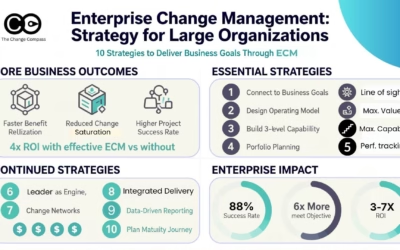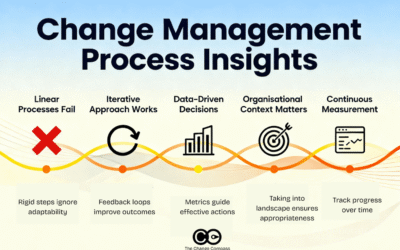One of the most feared aspect of change by organisations is its impact on performance. There is a wide variety of change which can determine the potential for performance dips during the change process. However, there is a significant body of research on the phenomenon of performance dip during system implementation. This refers to a temporary decrease in performance or productivity that often occurs when a new system is introduced or a significant change is made to an existing system. In this article we review key research studies on performance dips during change.
What are some of the research studies on performance dips during system implementation? Here are a few research studies that provide some insight into the degree of performance dips during system implementation:
- A study published in the Journal of Computer Information Systems in 2019 found that performance dips during ERP implementation projects can range from 10% to 25% on average, with some organizations experiencing dips as high as 40%.
- A study published in the Journal of Information Technology Management in 2011 found that performance dips during enterprise system implementation can range from 5% to 50% on average, depending on the organization and the type of system being implemented.
- A study published in the International Journal of Information Management in 2016 found that performance dips during electronic health record (EHR) system implementation can range from 5% to 60% on average, depending on the organization and the level of customization required for the EHR system.
What about for transformation programs? What are some of the findings on how much performance could dip during the transformational change process?
Here are some examples of the percentage of performance dips observed in various transformation programs:
- A study by McKinsey & Company found that organizations undergoing digital transformations typically experience a 10% to 15% dip in productivity during the implementation phase.
- A research report by the Hackett Group found that companies implementing large-scale enterprise resource planning (ERP) systems experience an average performance dip of 5% to 15% during the implementation phase.
- A case study of a large Australian bank’s transformation program found that the organization experienced a 10% to 20% dip in productivity during the implementation phase.
- A study of 10 organizations that had implemented new supply chain management systems found that they experienced an average productivity dip of 12% during the implementation phase.
The percentage of performance dips
The percentage of performance dip with transformation programs can vary widely depending on a variety of factors, such as the size and complexity of the transformation, the industry, the specific processes and systems being impacted, and the level of planning and support provided during the implementation.
It’s important to note that these percentages are only rough estimates, and the actual performance dip can vary widely depending on the specific context of the transformation program. Organizations can minimize the impact of performance dip by carefully planning and managing the implementation process, providing appropriate training and support to employees, and monitoring performance closely during and after the implementation.

Why causes the performance dip?
One key factor that contributes to performance dip is the learning curve associated with the new system. Users need time to become familiar with the new software or hardware and may initially struggle to complete tasks at the same speed or with the same level of accuracy as they did with the previous system.
Another factor is the disruption to established workflows and processes that can occur during system implementation. When a new system is introduced, it often requires changes to the way work is done, which can lead to confusion, feelings of loneliness, and delays until everyone adjusts to the new way of doing things.
Research has found that performance dip tends to be most pronounced in the initial stages of system implementation and can last anywhere from a few days to several months, depending on the complexity of the system and the level of support provided to users during the transition.
Overall, it is largely change management factors that can cause performance dips. For example:
- Resistance to change. When employees are asked to change the way they work, they may resist the change, leading to a decline in performance. Resistance can be due to various reasons, including fear of the unknown, lack of understanding of the reasons for the change, and concerns about job security.
- Implementation issues: When new processes or technologies are not implemented correctly, they may not work as intended, leading to a decline in performance. Implementation issues can be due to various reasons, including inadequate planning, insufficient resources, and unrealistic timelines.
- Communication breakdowns: When communication between stakeholders breaks down, it can lead to confusion and misunderstandings, leading to a decline in performance. Communication breakdowns can be due to various reasons, including inadequate planning, insufficient resources, and unrealistic expectations.
- Organizational culture: Organizational culture can also contribute to performance dips during transformation programs. When the organizational culture does not support change, employees may be resistant to it, leading to a decline in performance. Organizational culture can be due to various reasons, including leadership style, history, and values.
What about performance dips when there are multiple changes going on?
Research has shown that implementing multiple changes simultaneously can lead to a higher risk of performance dips. Here are some examples of research studies that have explored this issue:
- “The Effects of Multiple Change Initiatives on Perceptions of Organizational Change: Implications for Employee Outcomes” by Michael Tushman and Philip Anderson (2004): This study found that implementing multiple change initiatives at the same time can lead to increased uncertainty and confusion among employees, which can lead to a decline in performance.
- The Effect of Multiple Change Programs on Employee Well-being and Work Outcomes: A Longitudinal Study” by Michal Biron and Yair Bamberger (2012): This study found that implementing multiple change programs simultaneously can lead to increased stress and burnout among employees, which can negatively impact their performance in a negative workplace culture.
- “The Impact of Multiple Change Initiatives on Perceived Organizational Performance” by Matthew Davis and Stephen Taylor (2008): This study found that implementing multiple change initiatives simultaneously can lead to a decline in perceived organizational performance, which can impact employee morale and motivation.
- “Managing Multiple Organizational Changes: The Role of Prior Change Implementation and Timing of Change Initiatives” by Sebastian Kunert and Christiane Stenger (2019): This study found that implementing multiple changes simultaneously can lead to a higher risk of performance dips, but that prior experience with change implementation and careful timing of change initiatives can help to mitigate this risk.
Overall, these studies suggest that implementing multiple changes simultaneously can lead to a higher risk of performance dips. However, it is not that organisations should simply avoid implementing simultaneous changes. Morever, implementing simultaneous change is a fact of corporate life and continuous development. No modern organisation can survive by implementing only one singular change at a given time.

How to avoid performance dips across the portfolio of change initiatives
“Managing multiple change initiatives: the role of planning, sequencing, and implementation” by Jelena Spanjol and Susan Ashford (2018): This study found that careful planning and sequencing of change initiatives can help to reduce the negative impact of multiple changes on employee performance. The authors suggest that organizations should prioritize changes based on their strategic importance, and implement changes in a way that minimizes disruption to employees, incorporating AI to streamline processes.
In particular, the following 3 points have been highlighted.
- Prioritization: Organizations should prioritize changes based on their strategic importance, and implement changes in a way that minimizes disruption to employees. This can involve aligning changes with the organization’s overall strategy, and ensuring that employees understand how the changes will benefit the organization.
- Timing and sequence: The timing and sequence of changes can have a significant impact on employee performance. Organizations should consider the timing of changes relative to other initiatives, as well as the sequence of changes. For example, changes that are more disruptive to employees may be better implemented after other, less disruptive changes.
- Coordination: Effective coordination of multiple change initiatives is crucial to minimize the negative impact on employee performance. Organizations should ensure that there is clear communication and coordination between different departments and teams involved in the changes, and that there is adequate support and resources available to employees to help them adapt to the changes.
In fact similar findings have been concluded across various McKinsey studies as well. Having clear prioritisation and sequencing is absolutely integral to deliver significant value to the organisation across the initiative portfolio. 40% more value. That is correct. Organizations that are focused on prioritizing and sequencing across the initiative portfolio can gain 40% more value than those that do not.
If you’re keen on achieving 40% more value across your change portfolio have a chat to us about how The Change Compass digital solution can help you do just this.
How to avoid performance dip during system implementation change initiatives
Here are some research findings from different articles on how to reduce performance dips during system implementation projects:
1. “Reducing Performance Dip During Implementation of Large-Scale Information Systems” by David Straub and James King (1996):
• Encourage and support employee participation in the implementation process.
• Provide adequate training and education on the new system.
• Communicate effectively with employees about the changes and their impact.
• Provide adequate technical support and resources.
• Establish clear and specific goals for the implementation process.
2. “Managing multiple change initiatives: the role of planning, sequencing, and implementation” by Jelena Spanjol and Susan Ashford (2018):
• Develop a comprehensive change management plan that includes communication, training, and support.
• Prioritize and sequence change initiatives to minimize disruption and avoid overload.
• Provide clear and consistent communication about the changes and their impact.
• Involve employees in the design and implementation process.
• Monitor and address resistance to change.
3. “A multi-level model of employee attitudes toward organizational change” by W. Matthew Bowler et al. (2010):
• Foster a positive attitude toward change by providing clear and consistent communication, support, and training.
• Encourage employee participation and involvement in the change process.
• Provide resources and tools to help employees adapt to the change.
• Monitor and address resistance to change.
• Recognize and reward employee efforts to adapt to the change.
4. “Reducing the Performance Impact of Software Upgrades” by Albert J. Simard and Lionel P. Robert Jr. (2004):
• Develop a comprehensive training program that focuses on the most relevant features of the new system.
• Provide ample opportunities for practice and feedback.
• Establish a clear and specific timeline for the implementation process.
• Communicate effectively with employees about the changes and their impact.
• Provide technical support and resources to address any issues that arise.
In conclusion, research suggests that organizations that use a combination of these change strategies are more likely to avoid performance dips during transformation programs at a portfolio level. By carefully managing and monitoring the portfolio of initiatives, providing appropriate training and support to employees, and continuously improving performance, organizations can ensure a successful transformation that delivers the desired benefits.






